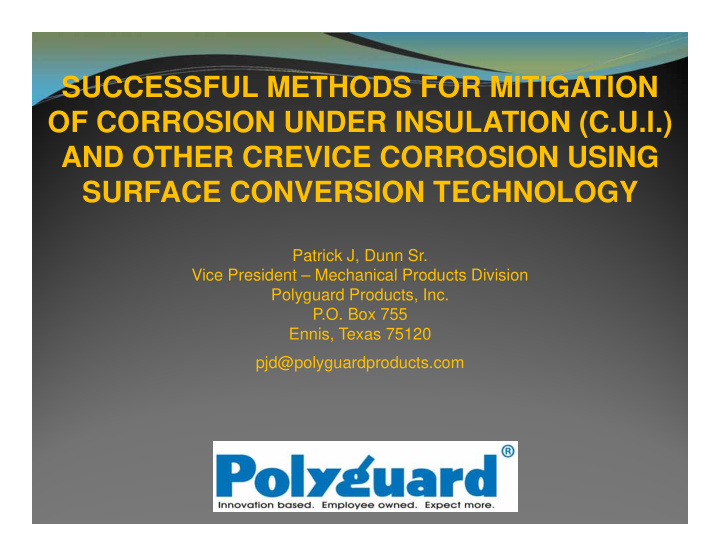



SUCCESSFUL METHODS FOR MITIGATION OF CORROSION UNDER INSULATION (C.U.I.) AND OTHER CREVICE CORROSION USING SURFACE CONVERSION TECHNOLOGY Patrick J, Dunn Sr. Vice President – Mechanical Products Division Polyguard Products, Inc. P.O. Box 755 Ennis, Texas 75120 pjd@polyguardproducts.com
Corrosion Under Insulation (CUI) CUI has been recognized as a problem in many industries Insulation is a necessary component of the system and is designed to: Save energy Control process temperatures Protect workers from high temperatures NACE Standard RP0198-98 1 is a good source of information, but electrolytes will eventually find their way into even the best system
Corrosion Under Insulation
Selecting the Correct Coating System Performance Operating T emperatures Moisture Resistance Anti-Corrosion Properties Application Surface Prep Dry/ Cure Time Labor & Equipment Requirements T otal Cost Product Application Ease of Maintenance Comparison of TOTAL installed cost is recommended
Anti-Corrosion Gel Performance Operating T emperatures – up to 350° Moisture Resistance – Hydrophobic Anti-Corrosion Properties – Mineralization & Buffering T echnology Application Surface Prep – SP-2 or better Dry/ Cure Time - None Labor & Equipment Requirements - Minimal Cost Installed cost is typically lower than other systems
Technology The technology works in three basic ways Barrier system – The specially formulated products have great adhesion characteristics and are hydrophobic to help keep moisture away from the substrate. M ineralization - Growing an engineered surface, or surface conversion – creating a surface which resists corrosion even if moisture gets to it . Buffering system – If moisture migrates through the gel, it is buffered to a high pH which is alkaline enough not to corrode metal.
Basic Science Metal surface: Oxides Metal carbonates Metal hydroxides METAL Surface conversion technology, also known as mineralization, is the ability to grow very thin minerals on metal surfaces. The mineral forms when reactants are Metal surface delivered to the surface of a metal or metal containing article. Substrates contribute ions that form a thin layer of METAL mineral, which chemically bonds to the surface of the metal and has been measured to be 50-200 angstroms thick. Lattice-forming oxides anchor to this surface layer and Polymerized metal silicate lattice polymerize into a three-dimensional inorganic framework METAL until the final surface is formed. Protected surface Extended surface Patents and patent applications cover unique formulations Mineral formation as well as the mineralized layer that is formed. METAL
Surface Formation Untreated steel surface M ineralized steel surface 10 um 10 um The presence of the mineralized layer can be confirmed by conventional analytical surface methods such as x-ray Photoelectron Spectroscopy (XPS) or Atomic Force M icroscope (AFM )
History of the Technology • Automotive – T echnology has been used in automotive applications for approximately 30 years. – Crevice Corrosion on Brake Cables • Industrial Applications – First industrial application was with the US Navy. Solved their #1 and #2 corrosion maintenance problem. – Watertight Door Latching Mechanisms – Deck Edge Elevator Wire Ropes
2 Y ear Salt Water Immersion Test Samples were prepared with fiberglass pipe insulation, surface conversion gel technology and placed in a 5% aerated salt bath. 1 1
2 Y ear Salt Water Immersion Test 10 DAYS 365 DAYS 81 DAYS 138 DAYS Samples were removed at timed intervals to determine protection of substrate
2 Y ear Salt Water Immersion Test TWO YEAR IMMERSION 55mil PER YEAR CORROSION RATE 1 3
2 Y ear Salt Water Immersion Test One uninsulated pipe in the test proved that the Gel does not undercut 1 4
Undercutting Test 2000 hrs 2000 hrs ASTM B117 Salt Spray ASTM B117 Salt Spray Gel Removed Gel Protected Steel Panel One unique property of gel surface conversion technology is that the gel will not undercut like a hardening barrier coating will.
Isothermal Testing 1 6
Weight Loss Testing 1 7
Corrosion Under Insulation (CUI)
Corrosion Under Insulation (CUI) Ammonia Piping Remediation
CUI - North Slope 2003
CUI - North Slope 2010 Inspection
CUI – Bundled Pipe Corrosion Remediation of Bundled Pipe System (BIR)
CUI – Bundled Pipe (BIR) X-Ray Inspection Through Insulation
CUI – Bundled Pipe (BIR) Remove Metal Jacket Remove Insulation
CUI – Bundled Pipe (BIR) Removal of Aged Mastic
CUI – Bundled Pipe (BIR) Physical Inspection of Pipes Removal of Rust Scale with wire brush and pot scrubber
CUI – Bundled Pipe (BIR) Install of Corrosion Gel Uniform Thickness Trowel
CUI – Bundled Pipe (BIR) Install Stand-offs and Insulation Install Metal Jacketing
DOWNHOLE CORROSION PROTECTION
Benefits of the Technology: Practical products and applications Multiple delivery systems Ease of application Insensitive to surface preparation and application conditions (SP-2 Hand T ool Cleaning or better) Superior anti-corrosion performance Environmentally benign Easy to inspect
Companies With Product Installations • Budweiser • OxyChem • General Mills • Equistar • Nestle • Union Carbide • Green Giant • Cytec • British Petroleum • Phillips • Best Brands Foods • MODOT-Missouri Dept of Transportaton • Philadelphia Gas • Nicor • Fred Meyer Foods • Tesoro Refinery • Unocal – AK Oil Platforms • Monarch Foods • Dot Foods • Safeway • ExxonMobil • U.S. Navy -Sakhalin Island Steam Lines • Kraft Foods Phase I • Dow Chemical Phase II • Schepps Dairy -Downhole Wells Alaska • ConocoPhillips - downhole • Alta-Dena Dairy • Coors Brewing • Conagra • Canada Hydro • Tyson Foods • Indiana University – Chiller Pipe • Tyson Chicken • Southgate Foods • Tyson Fresh Meats • Wal-Mart • Kroger • Scotia Bank Toronto (CHW) • US Cold Storage • Shepps Dairy • Publix Grocers • Chevron • Tombstone Pizza The entities listed above have used and/or specified surface conversion technology on one or more projects, however, the naming of these entities do not imply advertisement or public endorsement of the product.
Recommend
More recommend